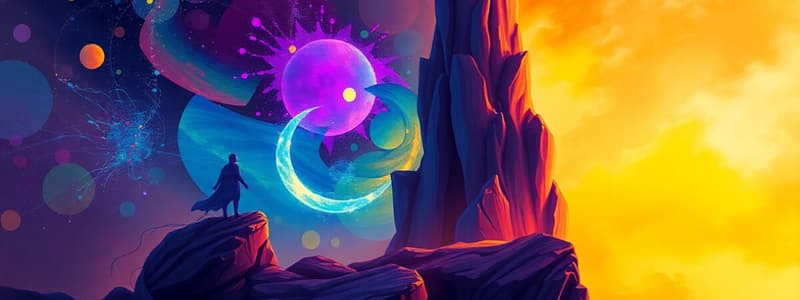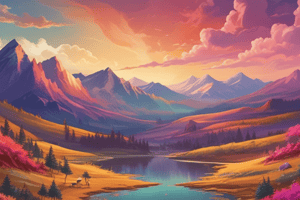Podcast
Questions and Answers
What is a key difference between graphic design and digital design?
What is a key difference between graphic design and digital design?
- Digital design offers more flexibility in design elements. (correct)
- Graphic design is strictly limited to traditional techniques.
- Digital design only uses static imagery.
- Graphic design can include animations.
Which of the following is NOT a fundamental principle of graphic design?
Which of the following is NOT a fundamental principle of graphic design?
- Animation (correct)
- Contrast
- Alignment
- Movement
Which statement about the elements of graphic design is accurate?
Which statement about the elements of graphic design is accurate?
- Only professionals can effectively use color in designs.
- Shape is irrelevant in graphic design composition.
- Texture adds depth and tactile quality to designs. (correct)
- Value refers to the importance of the design's message.
Which aspect of digital design allows for greater creativity compared to traditional graphic design?
Which aspect of digital design allows for greater creativity compared to traditional graphic design?
What principle of graphic design helps to unify various elements in a design?
What principle of graphic design helps to unify various elements in a design?
What effect do bright colors generally have?
What effect do bright colors generally have?
What happens to a hue when white is added?
What happens to a hue when white is added?
What does a shade involve?
What does a shade involve?
How is tone defined in the context of color?
How is tone defined in the context of color?
What term describes a color's level of vibrance or dullness?
What term describes a color's level of vibrance or dullness?
Which category of color is referred to as pastel colors?
Which category of color is referred to as pastel colors?
What is the definition of a hue in color theory?
What is the definition of a hue in color theory?
How does the value of a color change?
How does the value of a color change?
What type of experience does pattern texture primarily create?
What type of experience does pattern texture primarily create?
What can size differences in shapes create within a design?
What can size differences in shapes create within a design?
What effect does repeating a logo in formation result in?
What effect does repeating a logo in formation result in?
Which of the following is NOT a benefit of using space in design?
Which of the following is NOT a benefit of using space in design?
What are the primary colors that cannot be created by mixing other colors?
What are the primary colors that cannot be created by mixing other colors?
Which color is not a secondary color?
Which color is not a secondary color?
How can light and cool colors affect the perception of a small area?
How can light and cool colors affect the perception of a small area?
What is the result of mixing blue and yellow?
What is the result of mixing blue and yellow?
Which statement accurately describes pattern texture?
Which statement accurately describes pattern texture?
Which combination forms the tertiary color Yellow-Green?
Which combination forms the tertiary color Yellow-Green?
What should be avoided to enhance the effectiveness of size in a design?
What should be avoided to enhance the effectiveness of size in a design?
What best describes a complementary color scheme?
What best describes a complementary color scheme?
What design strategy would make a large area feel more intimate?
What design strategy would make a large area feel more intimate?
Which of the following is a characteristic of a monochromatic color scheme?
Which of the following is a characteristic of a monochromatic color scheme?
What is a practical use of color schemes?
What is a practical use of color schemes?
What is the primary purpose of the color wheel?
What is the primary purpose of the color wheel?
What is the main characteristic of a triadic color scheme?
What is the main characteristic of a triadic color scheme?
Which color scheme allows for one color to dominate while others serve as accents?
Which color scheme allows for one color to dominate while others serve as accents?
What is a key solution to the problem of colors that seem to vibrate?
What is a key solution to the problem of colors that seem to vibrate?
What type of texture appeals to the senses and often appears random in design?
What type of texture appeals to the senses and often appears random in design?
Which of the following best describes tactile texture?
Which of the following best describes tactile texture?
Which color scheme consists of colors that are next to each other on the color wheel?
Which color scheme consists of colors that are next to each other on the color wheel?
What is the purpose of using neutral colors like black, white, and gray in design?
What is the purpose of using neutral colors like black, white, and gray in design?
What distinguishes pattern texture from image texture?
What distinguishes pattern texture from image texture?
Flashcards are hidden until you start studying
Study Notes
Primary Colors
- Primary colors can't be created by mixing any other colors: red, blue, yellow
Secondary Colors
- Created by mixing equal parts of two primary colors
- Red + Blue = Violet
- Red + Yellow = Orange
- Blue + Yellow = Green
Tertiary Colors
- Created by mixing equal parts of a primary and secondary color
- Blue (primary) + Violet (secondary) = Blue-Violet
- Red (primary) + Violet (secondary) = Red-Violet
- Red (primary) + Orange (secondary) = Red-Orange
- Yellow (primary) + Orange (secondary) = Yellow-Orange
- Yellow (primary) + Green (secondary) = Yellow-Green
- Blue (primary) + Green (secondary) = Blue-Green
Color Schemes
- Use combinations of 2 or more colors for aesthetics and practical designs
- Aesthetic schemes create style and appeal
- Practical schemes used for camouflaging or high visibility
- Color harmony is a time-tested visual combination
Color Wheel
- Invented by Isaac Newton in 1666
- Tool for defining colors and their relationships to each other
Monochromatic
- Uses only one color or hue
- Use saturation and value to create variations
Complementary Colors
- Opposite each other on the color wheel
- Blue and Orange
- Red and Green
Graphic Design vs. Digital Design
- Graphic Design is static imagery
- Digital Design is adaptable elements in a digital space
- Includes animations, interactive pieces
- Anyone can create digital pieces
Principles of Graphic Design
- Alignment
- Hierarchy
- Contrast
- Repetition
- Composition
- Balance
- Movement
- Proximity
Contrast
- Creates emphasis through light vs. dark, thick vs thin
Repetition
- Ties individual elements together
Elements of Graphic Design
- Line
- Shape
- Form
- Color
- Texture
- Space
- Value
Uses of Color
- Bright colors convey a fun or modern vibe
- Desaturated colors often appear more serious or businesslike
Categories of Color
- Hue: a color
- Tint: White added to a hue
- Shade: Black is added to a hue
- Tone: Black and white added to a hue
Components of Color
- Hue: color family.
- Value (brightness): lightness or darkness determined by white or black
- Chroma (saturation): vibrance or dullness, determined by amount of gray
Color Schemes (Continued)
- Split-Complementary: uses the colors on either side of the complement
- Triadic: uses three equally spaced colors, forming a triangle on the wheel
- Analogous: uses colors next to each other on the wheel
- Tetradic: uses two complementary color pairs forming a rectangle
Color Mistakes
- Vibrating colors: solution is to tone it down, adjust lightness, darkness, or saturation
- Poor legibility: use neutral colors to balance the design
Texture
- The surface quality of an object or item
- Tactile: How the object feels to the touch
- Visual: How the object appears to feel, created with line, color, and shading
Types of Texture
- Image Texture: Combination of organic or geometric shapes and color, appears random, can be simple or complex
- Pattern Texture: Organic or geometric shapes and color but more structured, recognizable shapes, patterns are often repeated
Texture Use
- Creates a sensory experience
- Adds interest
- Provides visual relief
- Conveys meaning
- Forges relationships
PATTERN TEXTURE
- Repetition of line, shape, form, texture, and/or color
- Reflects the mood of the elements used
- Can be formal, informal, calm, playful
Value
- Light & Dark Contrast
- Mass & Volume
- Contrast & Comparison
- Readability
- Illusion of Form
Size
- Relationship between one shape's area to another
- Difference in size creates dynamic designs
- Equal size can cause confusion
- Important for hierarchy, legibility, focus, direction, tempo, pause, and reflection
Space
- 3D expanse the designer is working with
Space (Cont.)
- For a large area to feel intimate: furniture perpendicular to walls, furniture grouped by activity, large furniture on the floor
Space (Cont.)
- To make a small area feel spacious: allow for open areas and empty space, use mirrors, small prints, patterns, and textures, light, cool colors
- To make a small area feel spacious: allow floor to show, place large furniture near walls, furniture raised off the floor, minimal bulk
Studying That Suits You
Use AI to generate personalized quizzes and flashcards to suit your learning preferences.



